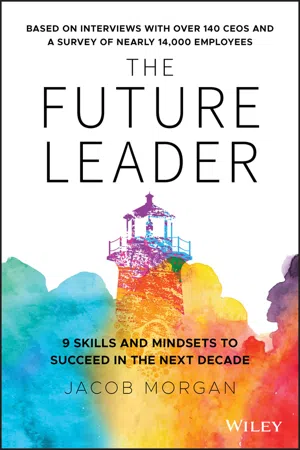
- English
- ePUB (mobile friendly)
- Available on iOS & Android
About this book
WINNER OF CMI MANAGEMENT BOOK OF THE YEAR 2021
Are you a future-ready leader? Based on exclusive interviews with over 140 of the world's top CEOs and a survey of nearly 14, 000 people.
Do you have the right mindsets and skills to be able to lead effectively in the next ten years and beyond? Most individuals and organizations don't even know what leadership will look like in the future. Until now.
There has been a lot written about leadership for the present day, but the world is changing quickly. What worked in the past won't work in the future. We need to know how to prepare leaders who can successfully navigate and guide us through the next decade and beyond. How is leadership changing, and why? How ready are leaders today for these changes? What should leaders do now?To answer these questions, Jacob interviewed over 140 CEOs from companies like Unilever, Mastercard, Best Buy, Oracle, Verizon, Kaiser, KPMG, Intercontinental Hotels Group, Yum! Brands, Saint-Gobain, Dominos, Philip Morris International, and over a hundred others. Jacob also partnered with Linkedin to survey almost 14, 000 of their members around the globe to see how CEO insights align with employee perspectives
The majority of the world's top business leaders that Jacob interviewed believe that while some core aspects of leadership will remain the same, such as creating a vision and executing on strategy, leaders of the future will need a new arsenal of skills and mindsets to succeed.
What emerged from all of this research is the most accurate groundbreaking book on the future of leadership, which shares exclusive insights from the world's top CEOs and never before seen research. After reading it, you will:
- Learn the greatest trends impacting the future of leadership and their implications
- Understand the top skills and mindsets that leaders of the future will need to possess and how to learn them
- Change your perception of who a leader is and what leadership means
- Tackle the greatest challenges that leaders of the future will face
- See the gap that exists between what CEOs identified versus what employees are actually experiencing
- Become a future-ready leader
This is the book that you, your team, and your organization must read in order to lead in the future of work.
Frequently asked questions
- Essential is ideal for learners and professionals who enjoy exploring a wide range of subjects. Access the Essential Library with 800,000+ trusted titles and best-sellers across business, personal growth, and the humanities. Includes unlimited reading time and Standard Read Aloud voice.
- Complete: Perfect for advanced learners and researchers needing full, unrestricted access. Unlock 1.4M+ books across hundreds of subjects, including academic and specialized titles. The Complete Plan also includes advanced features like Premium Read Aloud and Research Assistant.
Please note we cannot support devices running on iOS 13 and Android 7 or earlier. Learn more about using the app.
Information
PART 1
UNDERSTANDING THE ROLE OF THE LEADER
1
The Leadership Gap
Leaders Today Are Struggling
It's Time to Change
2
Three Essential Leadership Questions
- What is leadership and who is a leader?
- Should someone be called a leader or a manager?
- Is the leader of 2030 really going to be that different from the leader of today? And if so, how?
What Is Leadership and Who Is a Leader?
Table of contents
- Cover
- Table of Contents
- Introduction
- PART 1: UNDERSTANDING THE ROLE OF THE LEADER
- PART 2: TRENDS AND CHALLENGES SHAPING FUTURE LEADERS
- PART 3: THE FOUR MINDSETS OF THE NOTABLE NINE
- PART 4: THE FIVE SKILLS OF THE NOTABLE NINE
- PART 5: BECOMING THE FUTURE LEADER
- References
- Acknowledgments
- About the Author
- Additional Resources
- Index
- End User License Agreement